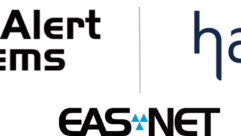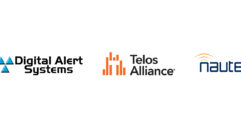LYNDONVILLE, N.Y. — Dec. 12, 2017 —
Monroe Electronics announced that the Advanced Television Systems Committee (ATSC) has approved the Advanced Emergency Alerting (AEA) specification as part of the A/331 standard, which is based primarily on designs submitted by Monroe Electronics and supported by broadcasters and equipment manufacturers across the industry. With the approval of the A/311 Signaling, Delivery, Synchronization, and Error Protection standard on Dec. 6, 2017, AEA has become an official function within the ATSC 3.0 suite of next-generation broadcast transmission standards, and the core element of next-generation emergency communications capabilities has been set.
“This is a significant milestone for emergency information capabilities in broadcast technology,” said Edward Czarnecki, senior director of strategic and government affairs for Monroe Electronics. “By approving this advanced emergency messaging feature of the standard, the ATSC is enabling broadcasters to leapfrog to IP-based, mobile, customizable, and media-rich emergency notifications to their audiences, with the potential for a range of first responder and public safety services as well. We deeply appreciate the amazing work of those broadcast and consumer electronics engineers from several countries who collaborated with us to establish this feature as part of the standard.”
Seeing a need for a specialized broadcast messaging format that fully leverages the next-generation capabilities of ATSC 3.0, and also portable across systems and national boundaries, Monroe Electronics proposed a new messaging format for advanced emergency alerting by TV. The ATSC standard’s AEA feature will enable a vastly improved user experience for TV viewers when it comes to emergency alerts, whether they’re watching through receivers on fixed screens, mobile phones, or portable devices such as tablets or vehicle-mounted displays. Furthermore, the feature allows broadcasters to be more than just a conduit for Emergency Alert System (EAS) messages; it gives them an opportunity to engage with their viewers. The AEA feature will also provide powerful new options to help public safety officials get more information out to viewers, resulting in a major public policy benefit.
“Advanced Emergency Alerting provides a direct connection for a wide range of urgent information from the station to the audience — including warnings, advisories, bulletins, and all manner of emergency information. The Emergency Alert System as we know it today will continue to be used by television broadcasters. However, Advanced Emergency Alerting will both complement and go beyond the narrow confines of today’s EAS,” Czarnecki continued. “Stations and consumers will benefit from more detailed and useful alert information; media, graphics, and live feeds; enhanced geotargeting; and even personalized notification capabilities — all delivered to ATSC 3.0 receivers in TVs and portable devices like tablets, laptops, and perhaps even smartphones.”
Using the AEA capability in ATSC 3.0, television stations will be able to send detailed, geotargeted alerts and warnings to the general viewing public or even to specific audiences such as first responders. Broadcasters can supplement those urgent messages with rich multimedia elements that make the alerts more informative than simple EAS messages.
In terms of the user experience, ATSC AEA will enable advanced options for interaction, such as allowing consumers to select the type, language, and display mode of notifications. Users will also be able to choose among text, audio, and video alerts, which will be important for those with accessibility challenges.
Flexible enough to handle both EAS messages and any other type of urgent communications, the specifications proposed by Monroe and ultimately adopted by ATSC will provide the foundation for the capabilities being advocated by the AWARN Alliance and others.
Now that the AEA specification has been officially adopted as part of ATSC 3.0, consumer receiver manufacturers can integrate this feature set into their product designs. As such, manufacturers could potentially include the AEA feature in television receivers, portable tablets, mobile devices, and home gateway devices.
Monroe Electronics designed the AEA specification to accommodate emergency communications requirements not just in the United States, but in Canada, Mexico, South Korea, and all other countries that use the ATSC suite of standards. For that reason, AEA could have significant international impact.
Taken together, all ATSC 3.0 standards will be the “glue” that enables broadcast protocol to exist in an internet environment, which means better pictures and sound, personalized and geotargeted viewing, mobile viewing, more robust emergency alerts, and the seamless integration of broadcasting programming with other IP-based services.
More information on ATSC 3.0, the A/331 standard, and the AEA feature in A/331 is available at
http://atsc.org/standards/atsc-3-0-standards/
.
# # #
About Monroe Electronics
Monroe Electronics began operations in 1954 designing and manufacturing specialized electrostatic discharge (ESD) instrumentation that continues today. From its headquarters in Lyndonville, New York, the company provides R&D, manufacturing, sales, and customer service for all Monroe Electronics, One-Net™, and Digital Alert Systems brands. Monroe Electronics’ Emergency Alert Systems (EAS) are the widely accepted standard for CATV with a hard-earned reputation for quality, reliability, and service to valued customers around the world. In October 2009, Digital Alert Systems, the leading innovator of next-generation Common Alerting Protocol (CAP) and EAS merged with Monroe Electronics to further extend its product offerings to radio and television broadcasters and better serve their collective customers into the future.
More information is available at
or
.
All trademarks appearing herein are the property of their respective owners.
Link to Word Doc:
www.wallstcom.com/Monroe/171212Monroe.docx
Photo Links:
www.wallstcom.com/Monroe/Monroe_CZARNECKI.jpg
Photo Caption:
Edward Czarnecki, Senior Director of Strategic and Government Affairs, Monroe Electronics
Share it on Twitter:
https://twitter.com/intent/tweet?text=ATSC%20Approves%20Advanced%20Emerg…










